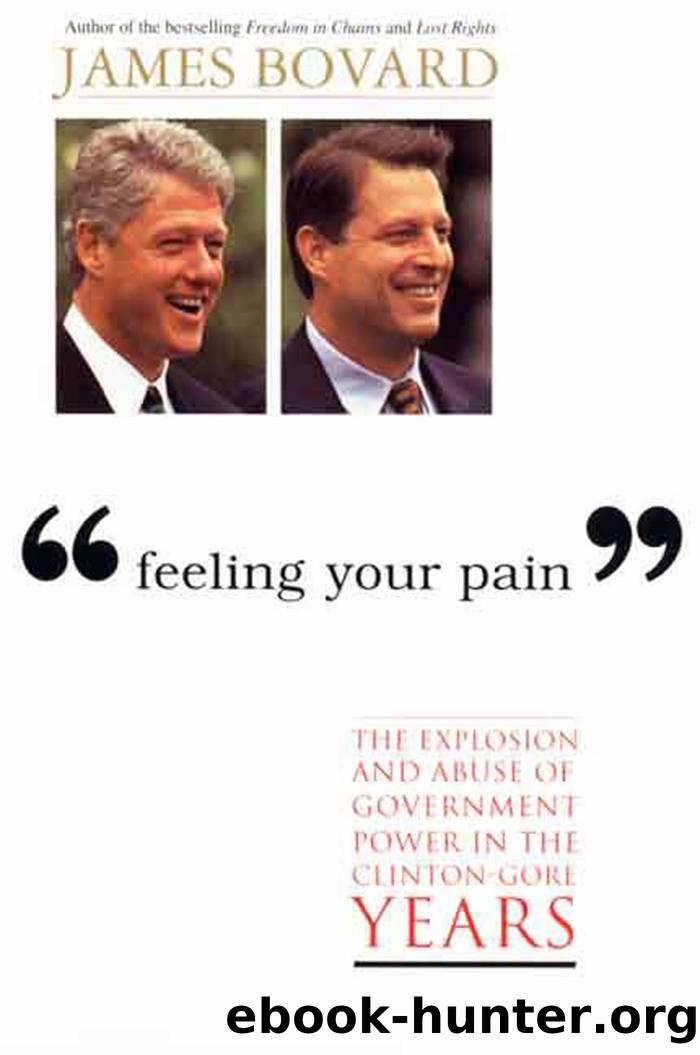Feeling Your Pain by James Bovard

Author:James Bovard
Language: eng
Format: epub
Published: 2018-10-02T00:00:00+00:00
Superfund made cleaning up abandoned waste sites far more hazardous than it otherwise would have been. Any company that came in to clean up a site could be held liable for the entire cleanup cost, even if it had had nothing to do with the original contamination. This is like holding a Boy Scout liable for all the future medical expenses of any old lady he helped cross the street.
Superfund strangled cities. Rep. Michael Oxley (R-Ohio) denounced the EPA for creating a “brownfields Berlin Wall” and complained that Superfund and its implementation of regulations “have driven jobs away, discouraged new investment, and exposed residents to contamination for a longer period of time.” 7 Lawyer James Thunder noted in 1998, “Superfund’s liability scheme caused developers to shun city ‘brownfields’ in favor of developing non-urban ‘greenfields’ … The Superfund law, and EPA’s administration of it, virtually suspended all cleanup of property unless EPA was in charge, delaying cleanup interminably. This placed the health of urban residents at risk.” 8 A U.S. Conference of Mayors inventory of brownfields sites found “180 cities reporting 19,000 sites representing more than 178,000 acres … a land area larger than the cities of Atlanta, Seattle and San Francisco combined.” 9
Superfund has also been a fiasco because of absurd cleanup standards. EPA presumes that children will visit former Superfund sites on a near-daily basis and eat the dirt. 10 EPA christened the Idaho Pole Company in Bozeman, Montana, a Superfund site; PCPs had leaked onto the ground during the treatment of telephone poles. EPA justified the Superfund designation based on the bizarre assumptions that the local government would authorize using the former industrial site for a mobile-home park; that the new mobile-home residents would insist on drilling private wells directly below them to tap and drink only the most polluted water they could find; and that the new residents would insist on growing their own food in back of their trailers, thus scarfing down a few more carcinogens. 11 Duke professor Kip Viscusi noted, “This hypothetical enthusiasm for living on Superfund sites is implausible in light of the fact that hazardous waste sites rank number one on the public’s list of environmental fears.” 12 Viscusi analyzed spending for Superfund cleanups and concluded: ‘‘The first 5 percent of expenditures eliminates 99.46 percent of the total expected cases of cancer averted by hazardous waste cleanup efforts. The remaining 95 percent of all cleanup costs achieves virtually nothing in terms of health risk reduction.’’ 13 Even more surprising, Viscusi found that “55 percent of the expenditures are made to eliminate under 0.1 percent of the risk.” 14 Viscusi concluded that the risk threshold that EPA used to launch Superfund sites was “quite comparable to many of the risks that we encounter in our daily lives, e.g., eating 40 tablespoons of peanut butter or traveling 10 miles by bicycle.” 15 William Cooper, an ecologist at Michigan State University, conceded that “if you had to do it [Superfund cleanups] on risk alone, you wouldn’t spend any money on these things.
Download
This site does not store any files on its server. We only index and link to content provided by other sites. Please contact the content providers to delete copyright contents if any and email us, we'll remove relevant links or contents immediately.
The Secret History by Donna Tartt(16611)
The Social Justice Warrior Handbook by Lisa De Pasquale(11486)
Thirteen Reasons Why by Jay Asher(7783)
This Is How You Lose Her by Junot Diaz(5754)
Weapons of Math Destruction by Cathy O'Neil(5032)
Zero to One by Peter Thiel(4818)
The Myth of the Strong Leader by Archie Brown(4786)
Promise Me, Dad by Joe Biden(4441)
Stone's Rules by Roger Stone(4413)
Beartown by Fredrik Backman(4405)
How Democracies Die by Steven Levitsky & Daniel Ziblatt(4393)
The Fire Next Time by James Baldwin(4338)
100 Deadly Skills by Clint Emerson(4072)
A Higher Loyalty: Truth, Lies, and Leadership by James Comey(4027)
Rise and Kill First by Ronen Bergman(4009)
The David Icke Guide to the Global Conspiracy (and how to end it) by David Icke(3876)
The Farm by Tom Rob Smith(3870)
Secrecy World by Jake Bernstein(3774)
The Doomsday Machine by Daniel Ellsberg(3726)
